Mercedes E400 Coupe covers all sporty, luxury needs
Filed under: Weekly test drives, Autos
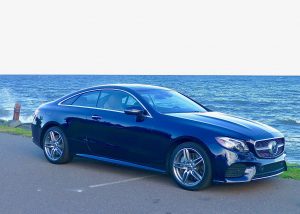
Mercedes has advanced technology filling its midsize E-Class sedans to the point that a sporty, 4-seat Coupe was the only way to turn.
By John Gilbert
You drive someplace in your Mercedes-Benz, and no matter which model — 2-door, 4-door, convertible, or SUV — you enjoy every second you’re behind the wheel. The feeling of refinement, of corraling all that power and channeling it into a luxurious body, is something you feel every foot of your drive.
When you park the Mercedes and climb out, the enjoyment and appreciation doesn’t end. Especially if you happen to be driving a 2018 Mercedes-Benz E400 4Matic Coupe. In the case of th E400 Coupe, it might be that your appreciation is heightened when you climb out and can take a few steps away and then look back at your prize.
A week with a test E400 4Matic Coupe wasn’t really fair. The car color was called Lunar Blue Metallic, and it was such a rich, dark blue that it defied normal definition. The first time my wife, Joan, walked out to the car with me, she got close and then said, “Oh. I thought it was black.” True, in subdued light, it looked like it might be a rich, black, but if you’re a blue fanatic, as I am, it might be the richest blue on the planet. Read more
Genesis G80 splits off to lift Hyundai’s image
Filed under: Weekly test drives, Autos
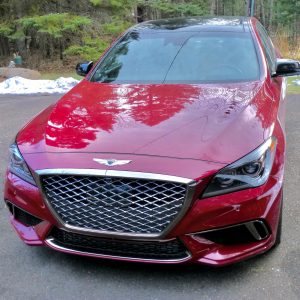
The Genesis model is now Hyundai’s separate luxury-sporty sedan line, amd the 2018 G80 AWD is a winner for all seasons.
By John Gilbert
When South Korea burst upon the elite level of auto design and technology, it was the 2011 Sonata that led the charge, with over-the-top contours, high-strength steel construction, and an advanced direct-injected 2.4-liter 4-cylinder engine with a lighter and more efficient in-house 6-speed transmission.
After that breakthrough in the midsize class, Hyundai went on to upgrade every engine and design to high-tech advancements. It also quickly added a larger and more luxurious Genesis sedan, which began life with a V8 engine that carried all of Hyundai’s self-taught technology. It won Car of the Year awards and the engine won Ward’s engine design awards.
My intention here is to renew acquaintances with the mainstream Genesis G80, a true combination of sportiness and luxury in a solid, strong-performing sedan. But before we get to the details of this beautifully redesigned G80, it still is important to scan Hyundai’s rapid expansion in the industry.
Hyundai added still another upscale super-luxury car called the Equus, above the Genesis, to present a full arsenal of vehicles, from tiny Accent, to compact Elantra, sporty — if oddball — Veloster coupe, the all-new Ioniq hybrid-or-electric compact, then to the Sonata, Azera, Genesis and Equus. On the side, its SUV group had the compact Tucson, and the larger Santa Fe, among others. All this time, Hyuundai had just taken on Kia as an affiliate, then partner, building parallel models and sharing in Hyundai’s breakthrough technology. The attempt now is to differentiate between Hyundai and Kia models, making Kia’s the sportier and Hyundai’s the more mainstream or luxurious.
As the 2017 model year blends into the 2018s, Hyundai is attempting to spin Genesis off into its own line, not unlike Acura for Honda, Infiniti for Nissan and Lexus for Toytoa, although far less prominent than those Japanese competitors. Hyundai eliminated the Equus moniker, condensing the car into the top-level Genesis model as the G90. The Genesis G70 is on the more compact, sporty side. In fact, the G70 is the Hyundai version of the much-promoted new Kia Stinger, which has been voted one of three finalists for North American Car of the Year.
Finally, I hear you say, we’re getting to today’s topic, which is the Genesis G80 — the Genesis model numerically between the sportiest G70 and the most luxurious G90.
Price range for the Genesis models is high-$30,000 for the G70, somewhere in the $50,000 range for the G80, and into the $70,000 level for the G90. Far beyond the mid-$20,000 to mid-$30,000 range of the Sonata.
With all of that stored away, the G80 is a superb sedan, living up to the rave reviews a colleague of mine has issued after buying a G80 a couple of years ago. It is, however, significantly redone for 2018, and the test model was, officially, the G80 AWD 3.3T Sport.
My test vehicle was not just a sporty or luxury sedan, but a stunning combination of every asset a car-buyer might want, need, or dream about. It handles with sporty flatness in turns, and is rock-solid over all manner of roadway, and you can dial it back from the sporty end of the adaptive Sport suspension to soften the ride. Read more
Land Rover? Range Rover? HSE Td6 is a prize
Filed under: Weekly test drives, Autos
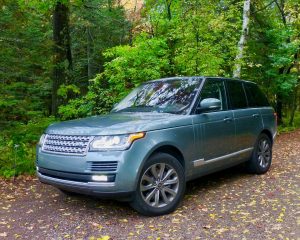
Always being refined and updated, the new Land Rover Range Rover HSE now comes with a powerful,. high-mileage 3.0 turbo-diesel.
By John Gilbert
My standard assessment of Land Rover vehicles is that they would be the SUV of choice if you wanted to drive from wherever you are to Hudson Bay, without using any roads.
Driving a new 2017 Land Rover Range Rover HSE Td6 for a week, including a highway trip from Duluth, Minnesota, to Chicago, reinforced my previous and long-standing assessment. With an exclamation point!
Some Land Rovers are Land Rovers, and others are Range Rovers, usually the higher-end models. The one I drove was the latest iteration of the standard “Land Rover Range Rover” and it broke new ground by being powered by a 3.0-liter V6 Turbodiesel engine, with a strong 254 horsepower, and an overwhelming 443 foot-pounds of torque, all harnessed through an 8-speed automatic transmission.
While diversifying its model range, you can now start with the Land Rover Discovery Sport, starting at $40,000; the stylish Land Rover Range Rover Evoque, starting at $43,000; the Land Rover Discovery starting at around $50,000; the new Land Rover Range Rover Velar, starting at $50,000; the Lan6d Rover Range Rover Sport, starting at $67,000; up to the Land Rover Range Rover, ranging from $87,000 to $201,000.
An intriguing array, and I want to drive all of them, never mind that I have no idea how they differentiate between a Range Rover and a Land Rover. The topic for the day will do, particularly now that I know my Land Rover Range Rover can run from $87,000 to over $200,000. The sticker price in the test vehicle showed a total of $95,645, and it was so well-equipped that I can’t imagine what all might be added to double its sticker.
In this specific model, you can choose from a 3.0-liter gas V6 in two forms, both supercharged, or the 3.0 Turbodiesel, or the top-line 5.0-liter V8, supercharged to 550 horsepower and 502 foot-pounds of torque. Compared to that, 254 horsepower sounds puny, but it’s the 443 foot-pounds of torque that matters, when you are pulling away from a start, scaling a hill, or towing something hefty.
The 3.0 Turbodiesel was quiet, almost unnervingly quiet, and when you told anyone that it was a diesel, they listened closely and doubted you. The comparative silence is a good thing, recalling the loud, smoky, clattering pre-clean diesels of past years.
But this one was equally impressive on the freeway, or climbing the steep avenues of Duluth, which is one of the stiffest road-test disciplines imaginable. When you head up Lake Avenue, knowing you need to climb eight blocks of about 20-degree grade, you instinctively step on the accelerator. In the new Range Rover Turbodiesel, such a move allows you to imagine what space travel might be like at launch-time. The vehicle nearly flies from the start with a strong surge of power and no hesitation. That’s what 443 foot-pounds of torque will do for even a hefty, 2-ton-plus SUV. Read more
Land Cruiser, Highlander offer wide SUV span
Filed under: Weekly test drives, Autos
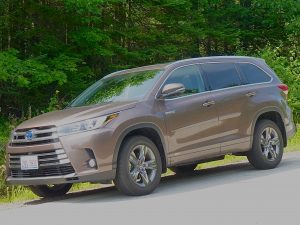
Toyota’s wide range of SUVs includes the high-tech new Highlander Hybrid that combines size with high-20s for fuel economy.
By John Gilbert
Let’s say that you intend to buy an SUV, and you need a large one, and you are a dedicated Toyota loyalist. You have looked at and rejected the Highlander, which is pretty big, and you are intent on going right to the top — the Land Cruiser.
Once you’ve decided to make the investment in the Land Cruiser, you know you are susceptible to one of those lucrative option lists, where you have to fight temptation to greatly increase the already large sticker price. So you ask what’s available. Herein is the biggest surprise of selecting a Land Cruiser.
There are no options.
Your only choice is the exterior color, and the interior color. That means once you’ve accepted the sticker price of $85,520, you can’t add any options. At that price, the Land Cruiser comes equipped, and we mean fully equipped. As in, loaded.
There isn’t even an optional engine available, which means you are forced to “choose” the 5.7-liter dual-overhead-camshaft V8, turning out 381 horsepower and 401 foot-pounds of torque, with full-time 4-wheel drive and a Torsen locking limited-slip center differential, plus its kinetic dynamic suspension, and multi-terrain selection that includes assets such as hill-start assist, off-road turn assist, and even crawl control, which makes the Land Cruiser sound more like some sort of Jeep.
Of course, it does carry the maximum pride of Toyota when it comes to off-road capability, dating back decades to when it was the company’s only off-road vehicle. It was built rugged then, and it continues to be over-engineered for normal family-hauling duty.
For those who might have thought large SUVs had gone the way of dinosaurs, and thought that maybe Chevrolet Suburbans were the only huge SUVs left, think again. The Land Cruiser did get a pretty good makeover a year ago, and the new model carries on, already equipped with a new 8-speed automatic transmission, the full Toyota Safety Series-P active safety equipment, and the ability to tow 8,100 pounds of trailer.
For its great length and roomy 3-row seating, the Land Cruiser drives lighter than seems possible. The suspension makes for a comfortable ride over all surfaces, which includes off-roading and also the challenging state of most urban streets and roadways.
Safety equipment includes lane-departure alert, pre-collision warning, radar cruise control, cross-traffic alert, blind-spot alert, trailer sway control, plus LED headlilghts, daytime running lights, and foglights. And, while not a safety feature, it also has the Entune JBL Audio upgrade. So are those two gigantic 11-inch screens affixed to the backs of the front bucket seats, with wireless headsets for monitoring your own DVDs if you’re a rear-seat occupant. Those back in the third row just have to suffer from long-distance viewing. Read more
Whatever the initials, Audi’s SQ5 is an SUV winner
Filed under: Weekly test drives, Autos
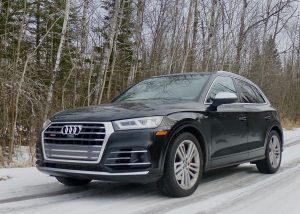
Redesigned Audi Q5 is roomy without bulk and adds the sportier SQ5 with 354 horsepower and 369 foot-pounds of torque from its turbo V6.
By John Gilbert
If you get confused by the model designations of various auto manufacturers, you can always rely on Germany’s Audi operation to assure us that the numbers still matter. You can move up the sedan models from smallest to largest by going A3, A4, A5, A6, A7, and A8, and the same holds true for the always changing fleet of SUVs, which are set off with a “Q,” as in Q3, Q5, Q7, and soon to be introduced Q8.
The Q7 is the traditional largest Audi SUV, and it underwent a significant change for 2017, with a fold-down third row seat and either a turbocharged 2.0-liter 4-cylinder or a supercharged 3.0-liter V6 that could bring the larger vehicle to life.
For 2018, Audi has redone the midsize Q5, which is pretty much the perfect compromise in size between those wanting to downsize from the larger SUVs on the market, and still might want to stay larger than the suddenly abundant smaller compact crossovers.
I recently had the chance to spend a week with a Q5, but it wasn’t just a Q5, it was Audi’s pleasantly upgraded sportier model, called the SQ5. In this case, the full name was SQ5 3.0T quattro tiptronic. Incidentally, Audi offers the “S” packages on all levels of cars and SUVs. Not that adding an S alleviates the alphabet soup of meaningful designations, but it does correctly imply sporty upgrades.
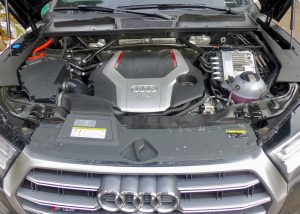
Switching from supercharging to turbocharging doesn’t restrict power, as the SQ5’s 354/369 power/torque numbers indicate.
Last time I had the chance to engage Audi engineers and marketing whizzes, I challenged them for varying from the trend to call their turbocharged engines with a “T” designation, and now were calling the 3.0 supercharged V6 a 3.0T. They shrugged it off as though I was being too particular, and pointed out that their countrymen at Mercedes and BMW had abandoned the precision of having the letters and numbers all make sense.
Now that I’ve had the chance to drive the new SQ5, it occurs to me that perhaps Audi was just running up a diversion for a few years until it could revise its engines. Instead of renaming the engine with an “S,” it instead redid the 3.0 V6 with a turbocharger instead of supercharger.
The difference is more than just subtle. A supercharger is driven by a belt off the alternator, designed to blow an extra high charge of air into the intake, which sucks in more gas and provides a hard increase in horsepower. A turbocharger is a turbine-driven device that does almost the same thing, but it gathers up its power from siphoning off some exhaust gases that would be heading out the tailpipes, and using that current of air to spin the turbine wheel and blow in the higher charge of air, and thus air-fuel mixture.
The major difference is that there is an inherent hesitation under brisk acceleration while the turbo “spools up” to speed. Modern technology has gone a long way toward eliminating the turbo lag, to the point it’s pretty unnoticeable.
So Audi, which used turbocharging before most of its competitors on cars and SUVs, apparently has veered away from the supercharger to the turbocharger in the new SQ5, which might be easier coordinated with the engine-management computer.
All I can say is the turbocharged 3.0 provided quick takeoffs and smooth passing power. The 3.0-turbo delivers 354 horsepower and a whopping 369 foot-pounds of torque in the new SQ5, through an 8-speed automatic that shifts smoothly, or can be manually shifted by steering-wheel paddles.
For comparison purposes, the supercharged 3.0 in the Q7 provides 333 horsepower and 325 foot-pounds of torque in the larger, 7-passenger vehicle, but it is interesting that the turbo offers more power and torque than the supercharged engine, allowing the SQ5 to get to 60 in more than a second less than the same engine in the Q7.
Both the Q5 and Q7 also offer the choice of a potent 2.0-liter 4, both with 252 horsepower and 273 foot-pounds of torque. For my money, the 4 would be more than adequate and could get you about 28 miles per gallon, compared to the 24 mpg maximum I attained in the SQ5.
The redesign makes the new SQ5 lower and sleeker that its predecessor, and it looked sleeker still in its Mythos Black Metallic sheet metal, set off with a stunning Magma Red leather interior with the S Package. One of the signature features of all Audis in recent years is their massive, 6-sided grilles. On some vehicles they are attractive, and on others just plain imposing. On the SQ5, the whole front end is lower than it used to be, so the big grille becomes something of a horizontal take on a vertical shape. I like it.
The SQ5 has a sticker price of $54,300, equipped with all the usual technology and safety features such as stabilization control, and comfort items like heated seats. Digging into the option bin for the S-Sport, Prestige, and Driver assistance packages, the sticker price rises to $68,750. That gives you 21-inch alloy wheels with high-performance all-season Pirelli tires, head-up display, dual-pane acoustic glass, Band & Olufsen 3D sound system, the navigation system, Nappa leather interior, and adaptive air suspension.
The nav system itself is an amazing feature. It comes on the large dash screen, and you can switch it around to view a flat map, a 3D map, or a Google Earth view of your surroundings taken from actual satellite camera work.
In addition, you look at the instrument panel and see a large circular gauge with an analog tachometer with a digital speedometer readout in the middle. Or, you can summon up two circular gauges, one for speedometer and the other with a tachometer and other information. But if you click the button for “View,” the gauges are diminished in size and split wider apart, while the entire width of the instrument panel becomes a view of the territory ahead.
Using the Google Earth view on the instrument panel, then parking at my home in the rural area outside of Duluth, Minnesota, I could wind in for a close-up view that actually showed a satellite photo of my house, and garage, located in the midst of some thick woods. Amazing
The electronic stabilization control has your choice of settings that completely change the personality of the SQ5. You can click lift/offroad, Allroad, Comfort, Auto, Dynamic, or Individual, and get ride firmness and power changes to suit every taste.
Audi’s array of LED lights is another special feature. Not only the headlights and driving lights, but taillights too, including a very neat LED underline under the taillights. If you happen to turn on the 4-way flashers, the rear end turns into a very creative light show.
I spotted a disabled car on a divided 4-lane highway near Duluth, and the car barely made it onto the left turn lane. I stopped behind the car, turned on my hazard flashers, and checked to find the guy was out of gas. A pickup truck came along and pulled in to stop behind me, and when I told the driver it was OK, he said: “Those are great tail-lights on that Audi.”
We ended up standing there, safely out of traffic, discussing the features of the car. “I can’t believe how neat those lights are,” he said. “Is there an Audi dealer in Duluth?”
I told him there wasn’t, but the Twin Cities dealers are only a couple hours away. He said, “Well, if there was a dealer here, I’d buy one of those.”
Maybe Audi could fit a mini-dealership into the double left-turn lane of the highway.



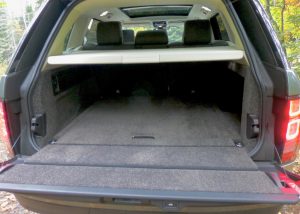
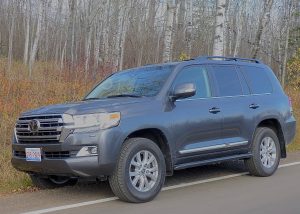


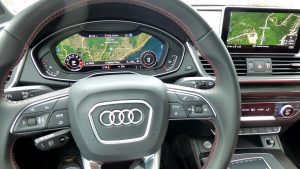
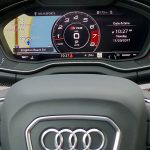
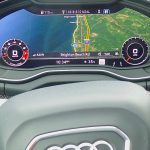

 John Gilbert is a lifetime Minnesotan and career journalist, specializing in cars and sports during and since spending 30 years at the Minneapolis Tribune, now the Star Tribune. More recently, he has continued translating the high-tech world of autos and sharing his passionate insights as a freelance writer/photographer/broadcaster. A member of the prestigious North American Car and Truck of the Year jury since 1993. John can be heard Monday-Friday from 9-11am on 610 KDAL(www.kdal610.com) on the "John Gilbert Show," and writes a column in the Duluth Reader.
John Gilbert is a lifetime Minnesotan and career journalist, specializing in cars and sports during and since spending 30 years at the Minneapolis Tribune, now the Star Tribune. More recently, he has continued translating the high-tech world of autos and sharing his passionate insights as a freelance writer/photographer/broadcaster. A member of the prestigious North American Car and Truck of the Year jury since 1993. John can be heard Monday-Friday from 9-11am on 610 KDAL(www.kdal610.com) on the "John Gilbert Show," and writes a column in the Duluth Reader.